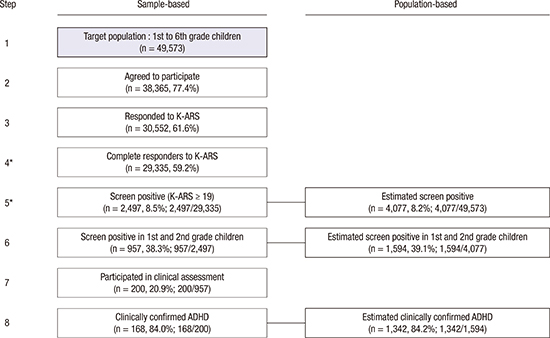1. American Psychiatric Association. Diagnostic and Statistical Manual of Mental Disorders: DSM-IV. 4th ed. Washington, D.C.: American Psychiatric Association;1994.
2. Faraone SV, Sergeant J, Gillberg C, Biederman J. The worldwide prevalence of ADHD: is it an American condition? World Psychiatry. 2003; 2:104–113.
3. Biederman J. Attention-deficit/hyperactivity disorder: a life-span perspective. J Clin Psychiatry. 1998; 59:Suppl 7. 4–16.
4. Kim Y, Cho SC, Kim BN, Hong YC, Shin MS, Yoo HJ, Kim JW, Bhang SY. Association between blood lead levels (<5 μg/dL) and inattention-hyperactivity and neurocognitive profiles in school-aged Korean children. Sci Total Environ. 2010; 408:5737–5743.
5. Kim SJ, Kim BN, Cho SC, Kim JW, Shin MS, Yoo HJ, Kim HW. The prevalence of specific phobia and associated co-morbid features in children and adolescents. J Anxiety Disord. 2010; 24:629–634.
6. Park S, Cho MJ, Chang SM, Jeon HJ, Cho SJ, Kim BS, Bae JN, Wang HR, Ahn JH, Hong JP. Prevalence, correlates, and comorbidities of adult ADHD symptoms in Korea: results of the Korean epidemiologic catchment area study. Psychiatry Res. 2011; 186:378–383.
7. Dong HL, Oakland T, Jackson G, Glutting J. Estimated prevalence of attention-deficit/hyperactivity disorder symptoms among college freshmen: gender, race, and rater effects. J Learn Disabil. 2008; 41:371–384.
8. Yoo HI, Cho SC, Kim BN, Kim SY, Shin MS, Hong KE. Psychiatric morbidity of second and third grade primary school children in Korea. Child Psychiatry Hum Dev. 2005; 36:215–225.
9. Park S, Kim BN, Cho SC, Kim JW, Shin MS, Yoo HJ. Prevalence, correlates, and comorbidities of DSM-IV psychiatric disorders in children in Seoul, Korea. Asia Pac J Public Health. 2015; 27:NP1942–51.
10. Cho SC, Kim BN, Kim JW, Rohde LA, Hwang JW, Chungh DS, Shin MS, Lyoo IK, Go BJ, Lee SE, et al. Full syndrome and subthreshold attention-deficit/hyperactivity disorder in a Korean community sample: comorbidity and temperament findings. Eur Child Adolesc Psychiatry. 2009; 18:447–457.
11. Kim YS, So YK, Noh JS, Choi NK, Kim SJ, Koh YJ. Normative data on the Korean ADHD Rating Scales (K-ARS) for parents and teacher. J Korean Neuropsychiatr Assoc. 2003; 42:352–359.
12. Shin MS, Cho S, Chun SY, Hong KE. A study of the development and standardization of ADHD diagnostic system. J Child Adolesc Psychiatry. 2000; 11:91–99.
13. Ford T, Goodman R, Meltzer H. The British Child and Adolescent Mental Health Survey 1999: the prevalence of DSM-IV disorders. J Am Acad Child Adolesc Psychiatry. 2003; 42:1203–1211.
14. Baumgaertel A, Wolraich ML, Dietrich M. Comparison of diagnostic criteria for attention deficit disorders in a German elementary school sample. J Am Acad Child Adolesc Psychiatry. 1995; 34:629–638.
15. Bener A, Qahtani RA, Abdelaal I. The prevalence of ADHD among primary school children in an Arabian society. J Atten Disord. 2006; 10:77–82.
16. Gómez-Beneyto M, Bonet A, Catalá MA, Puche E, Vila V. Prevalence of mental disorders among children in Valencia, Spain. Acta Psychiatr Scand. 1994; 89:352–357.
17. Cornejo JW, Osío O, Sánchez Y, Carrizosa J, Sánchez G, Grisales H, Castillo-Parra H, Holguín J. Prevalence of attention deficit hyperactivity disorder in Colombian children and teenagers. Rev Neurol. 2005; 40:716–722.
18. Bianchini R, Postorino V, Grasso R, Santoro B, Migliore S, Burlò C, Tata C, Mazzone L. Prevalence of ADHD in a sample of Italian students: a population-based study. Res Dev Disabil. 2013; 34:2543–2550.
19. Skounti M, Philalithis A, Galanakis E. Variations in prevalence of attention deficit hyperactivity disorder worldwide. Eur J Pediatr. 2007; 166:117–123.
20. Catalá-López F, Peiró S, Ridao M, Sanfélix-Gimeno G, Gènova-Maleras R, Catalá MA. Prevalence of attention deficit hyperactivity disorder among children and adolescents in Spain: a systematic review and meta-analysis of epidemiological studies. BMC Psychiatry. 2012; 12:168.
21. Polanczyk G, de Lima MS, Horta BL, Biederman J, Rohde LA. The worldwide prevalence of ADHD: a systematic review and metaregression analysis. Am J Psychiatry. 2007; 164:942–948.
22. Blázquez-Almería G, Joseph-Munné D, Burón-Masó E, Carrillo-González C, Joseph-Munné M, Cuyàs-Reguera M, Freile-Sánchez R. Results of screening for symptoms of attention deficit disorder with or without hyperactivity in schools by means of the ADHS scale. Rev Neurol. 2005; 41:586–590.
23. Cardo E, Servera M, Llobera J. Estimation of the prevalence of attention deficit hyperactivity disorder among the standard population on the island of Majorca. Rev Neurol. 2007; 44:10–14.
24. García-Jiménez MC, López-Pisón J, Blasco-Arellano MM. The primary care paediatrician in attention deficit hyperactivity disorder. An approach involving a population study. Rev Neurol. 2005; 41:75–80.
25. Staller J, Faraone SV. Attention-deficit hyperactivity disorder in girls: epidemiology and management. CNS Drugs. 2006; 20:107–123.
26. Park J. Gauging gender equality in terms of household labor division and gender-role perception. Health Welf Policy Forum. 2013; 199:28–38.
27. Bálint S, Czobor P, Mészáros A, Simon V, Bitter I. Neuropsychological impairments in adult attention deficit hyperactivity disorder: a literature review. Psychiatr Hung. 2008; 23:324–335.







 PDF
PDF ePub
ePub Citation
Citation Print
Print





 XML Download
XML Download